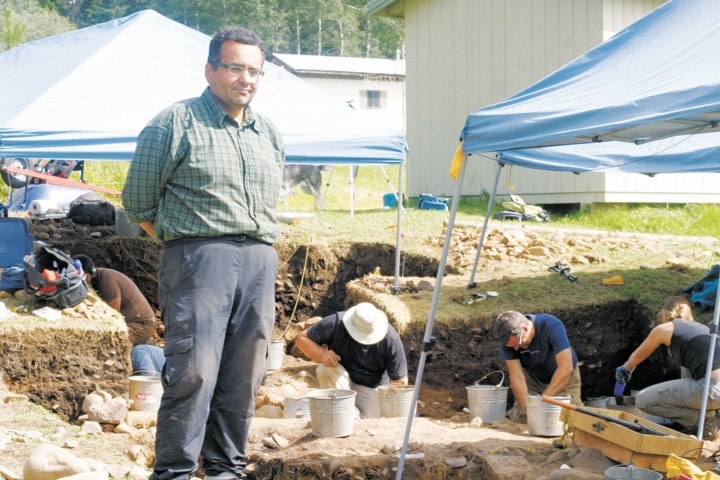Standing on what was once the floor of a longhouse in Carrier village built by the mouth of the Babine River, archeology student Adam Kantakis bends to point out a corner of folded birchbark just visible in the freshly dug soil.
If lab tests on the birchbark and other organic materials found at the village site this summer prove at least as old as those found during a smaller 2009 excavation nearby, the longhouse may be 1,500 years old or older.
Kantakis, one of several graduate students working under UNBC professor Farid Rahemtulla, says the birchbark is likely the corner of what was once large container, about three feet wide at the mouth, that Carrier peoples used to store smoked salmon, berries and other household goods.
It is one of some 400 artifacts recovered from the site so far on a dig funded by the Lake Babine Nation.
Some, like the remnants of a brick oven, may date to a time before contact between European settlers and the first nations peoples who fished and hunted in the Babine and Nilkitkwa watersheds.
Others, like a Hudson’s Bay Company harmonica, a cigar cutter, and a flint-fired musket ball, likely date from as recently as the late 1790s.
While it’s too early to say for sure, luxury items like the harmonica, trade beads and others suggest that the riverside village, rich in salmon, was a major and perhaps wealthy hub for Babine peoples.
“We’ve only done a small part of it,” Kantakis said late last month.
“And we’re down to the last two, three days of excavation.”

Professor Rahemtulla, who was invited by the LBN to lead led the first excavation in the area in 2009, says the 40 square metres that the team dug the summer is just the start of what could be done.
“It’s unusual to see a village this large in the northern interior,” Rahemtulla said.
“But it doesn’t mean there aren’t more here,” he added. “It’s just that we haven’t explored it yet.”
Rahemtulla explained that except for a pair of 8,000 and 10,000 year-old sites near Prince George and some excavations near Hagwiliget, very little archaeological excavation has been done in northern B.C.
Dating artifacts and running a large dig team is expensive work, he said, and tends to cluster along older, coastal sites or closer to the large universities in the Lower Mainland.
That fact alone makes excavating the Babine River fishing village exciting, but Rahemtulla believes it may also be unique for other reasons.
Like a similar village site at Lilloet, along the Fraser River, Rahemtulla believes the Babine village may stand at a kind of sweet spot—a place where the salmon have shed just enough fat in their journey back to their spawning grounds that they are perfect for preserving.
“This may be one of those places—I don’t know,” he said. “Right now it’s just a hunch.”
Rahemtulla said his team can make a few interpretations on-site, but most of the work will happen over the rest of the year, as they do mass-spectrometry dating tests and run sketches of the excavated walls into a 3D computer model.
“We’re here for a few weeks, but we’ll spend months and months analyzing it.”
And no one has excavated a longhouse like this in the interior before, says student Cory Hackett.
With its long rectangular shape, it seems to have a far more coastal style, rather than the round pit houses that so far seem more typical in interior B.C..

Even before man-made spawning channels were installed at Pinkut Creek and Fulton River, the Babine/Nilkitkwa system makes it the largest natural lake in B.C. and has likely supported a large number of salmon for hundreds of years.
Behind him, fisheries workers with the Lake Babine Nation work a steel weir that works not too differently than the wooden weirs that the first nation used up until 1906—a fence that spanned the river with several platforms where fishermen would stand and use dip nets.
According to the so-called Barricade Treaty, members of the LBN were forced to move upriver to the current site of Fort Babine in 1906, and their wooden weir dynamited two years later to meet the demands of commercial fisheries in the lower Skeena.
“The argument was that downriver there wasn’t enough salmon,” Hackett said. “But that wasn’t the problem. The problem was fishery management.”
A strong salmon run likely explains why the longhouse depression that the UNBC team is excavating is just one of several along a 700-metre stretch of the riverbank.
But Hackett said that at this point, the team has a lot of work to do—the story behind the longhouse’s coastal features, for example, is still far from explained.
“Really, we don’t know why,” he said. “It’s unexplored territory.”
